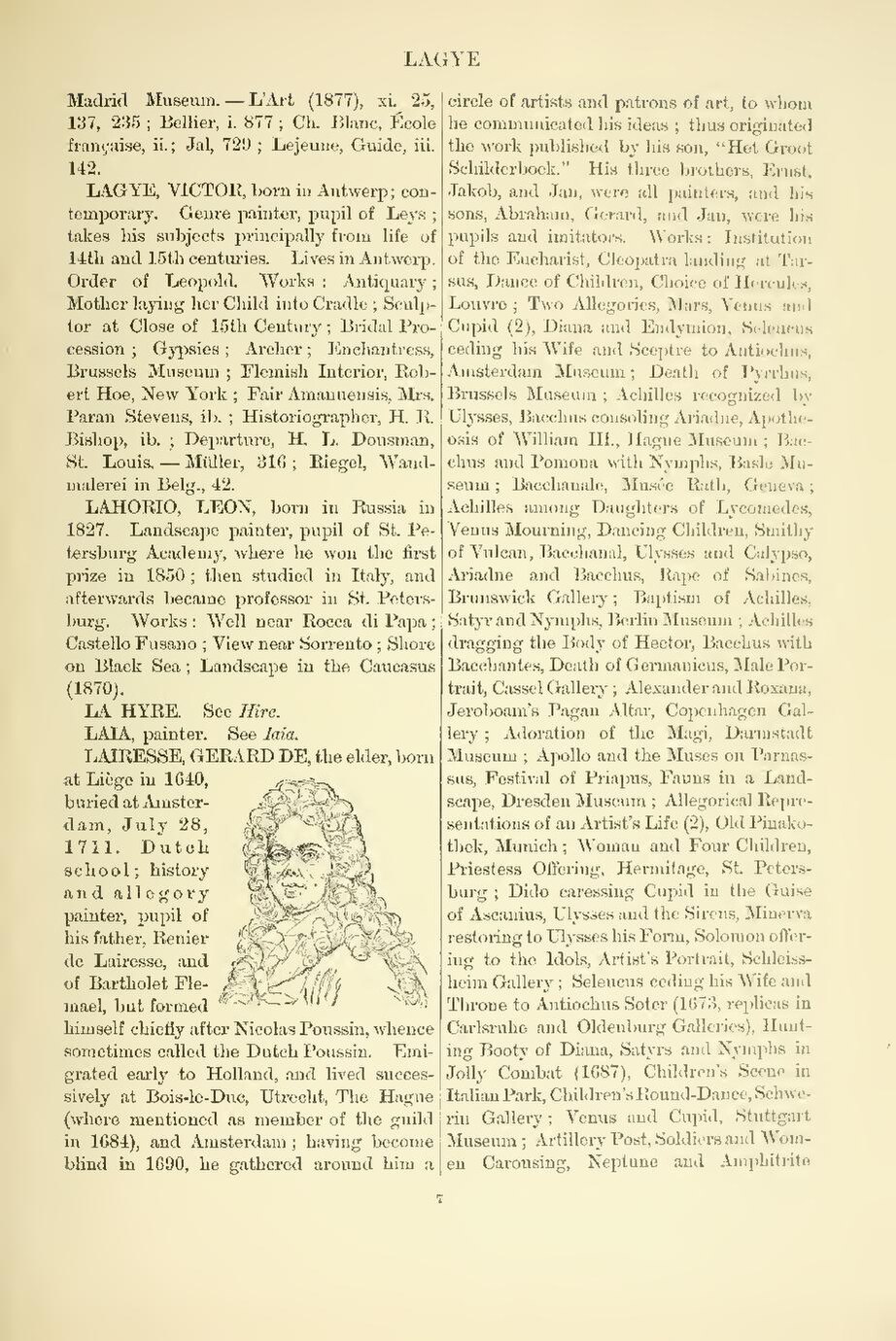Madrid Museum.—L'Art (1877), xi. 25, 137, 235; Bellier, i. 877; Ch. Blanc, École française, ii.; Jal, 729; Lejeune, Guide, iii. 142.
LAGYE, VICTOR, born in Antwerp; contemporary.
Genre painter, pupil of Leys;
takes his subjects principally from life of
14th and 15th centuries. Lives in Antwerp.
Order of Leopold. Works: Antiquary;
Mother laying her Child into Cradle; Sculptor
at Close of 15th Century; Bridal Procession;
Gypsies; Archer; Enchantress,
Brussels Museum; Flemish Interior, Robert
Hoe, New York; Fair Amanuensis, Mrs.
Paran Stevens, ib.; Historiographer, H. R.
Bishop, ib.; Departure, H. L. Dousman,
St. Louis.—Müller, 316; Riegel, Wandmalerei
in Belg., 42.
LAHORIO, LEON, born in Russia in
1827. Landscape painter, pupil of St. Petersburg
Academy, where he won the first
prize in 1850; then studied in Italy, and
afterwards became professor in St. Petersburg.
Works: Well near Rocca di Papa;
Castello Fusano; View near Sorrento; Shore
on Black Sea; Landscape in the Caucasus
(1870).
LA HYRE. See Hire.
LAIA, painter. See Iaia.
An image should appear at this position in the text. To use the entire page scan as a placeholder, edit this page and replace "{{missing image}}" with "{{raw image|Cyclopedia of painters and paintings (IA cyclopediaofpain03cham).pdf/29}}". Otherwise, if you are able to provide the image then please do so. For guidance, see Wikisource:Image guidelines and Help:Adding images. |
LAIRESSE, GERARD DE, the elder, born
at Liège in 1640,
buried at Amsterdam,
July 28,
1711. Dutch
school; history
and allegory
painter, pupil of
his father, Renier
de Lairesse, and
of Bartholet Flemael,
but formed
himself chiefly after Nicolas Poussin, whence
sometimes called the Dutch Poussin. Emigrated
early to Holland, and lived successively
at Bois-le-Duc, Utrecht, The Hague
(where mentioned as member of the guild
in 1684), and Amsterdam; having become
blind in 1690, he gathered around him a
circle of artists and patrons of art, to whom
he communicated his ideas; thus originated
the work published by his son, "Het Groot
Schilderboek." His three brothers, Ernst,
Jakob, and Jan, were all painters, and his
sons, Abraham, Gerard, and Jan, were his
pupils and imitators. Works: Institution
of the Eucharist, Cleopatra landing at Tarsus,
Dance of Children, Choice of Hercules,
Louvre; Two Allegories, Mars, Venus and
Cupid (2), Diana and Endymion, Seleucus
ceding his Wife and Sceptre to Antiochus,
Amsterdam Museum; Death of Pyrrhus,
Brussels Museum; Achilles recognized by
Ulysses, Bacchus consoling Ariadne, Apotheosis
of William III, Hague Museum; Bacchus
and Pomona with Nymphs, Basle Museum;
Bacchanale, Musée Rath, Geneva;
Achilles among Daughters of Lycomedes,
Venus Mourning, Dancing Children, Smithy
of Vulcan, Bacchanal, Ulysses and Calypso,
Ariadne and Bacchus, Rape of Sabines,
Brunswick Gallery; Baptism of Achilles,
Satyr and Nymphs, Berlin Museum; Achilles
dragging the Body of Hector, Bacchus with
Bacchantes, Death of Germanicus, Male Portrait,
Cassel Gallery; Alexander and Roxana,
Jeroboam's Pagan Altar, Copenhagen Gallery;
Adoration of the Magi, Darmstadt
Museum; Apollo and the Muses on Parnassus,
Festival of Priapus, Fauns in a Landscape,
Dresden Museum; Allegorical Representations
of an Artist's Life (2), Old Pinakothek,
Munich; Woman and Four Children,
Priestess Offering, Hermitage, St. Petersburg;
Dido caressing Cupid in the Guise
of Ascanius, Ulysses and the Sirens, Minerva
restoring to Ulysses his Form, Solomon offering
to the Idols, Artist's Portrait, Schleissheim
Gallery; Seleucus ceding his Wife and
Throne to Antiochus Soter (1673, replicas in
Carlsruhe and Oldenburg Galleries), Hunting
Booty of Diana, Satyrs and Nymphs in
Jolly Combat (1687), Children's Scene in
Italian Park, Children's Round-Dance, Schwerin
Gallery; Venus and Cupid, Stuttgart
Museum; Artillery Post, Soldiers and Women
Carousing, Neptune and Amphitrite
